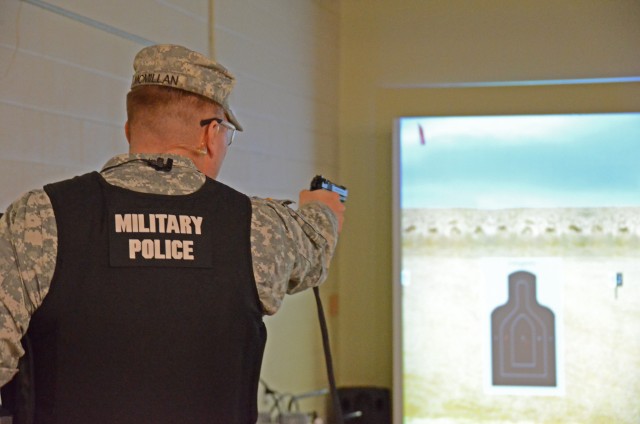Joint Base Lewis-McChord Law Enforcement Officers are participating in the first digital engagement skills training scenario specifically designed for military and Department of Defense law enforcement officers.
Engagement Skills Training is a virtual skills training system that replicates small arms fire with high precision. In layman's terms, it's like an interactive video game where Soldiers can see the battlefield in front of them and engage simulated enemy with real weapons electronically tethered to the system that very accurately tracks where you fire. It is so accurate that Soldiers can qualify on the system.
The Army is preparing to combine the M4 Carbine Rifle and M9 Pistol qualification for military and DOD law enforcement officers. The new qualification is more realistic to the type of shooting law enforcement officers may experience while on duty.
"This new training is putting the Military Police Corps into the 21st Century for law enforcement marksmanship training," said Mike Hayes, Chief Law Enforcement Trainer for Joint Base Lewis-McChord Directorate of Emergency Services.
Soldiers in the 51st Military Police Detachment, Joint Base Lewis-McChord Provost Marshal Office, and Police Officers in the Directorate of Emergency Services, participated in the new Engagement Skills Trainer 2000 exercise earlier this month on JBLM.
"This training was great practice," said Spc. Michael J. McMillan, 51st Military Police Detachment. "It made me focus on the fundamentals and how I prepare to engage targets."
Not only will the new EST exercise prepare our law enforcement officers for duty, it will also save the Army money.
"Bullets cost money," said Hayes. "This EST program after it was built doesn't cost anything."
The scenario uses the equipment currently being used in digital EST 2000s across the Army. The new EST digital military police qualification tables were built by Bryan Reed, EST 2000 Instructor/Operator at Lewis-North
"Mr. Hayes approached our team with an actual requirement in October 2015 and provided us the new Law Enforcement Weapons and Training Qualifications manual", said Terry Ingle, Chief of the Virtual Simulations Branch on Joint Base Lewis-McChord.
The JBLM Department of the Army Civilian Police made a few tweaks to the program built by Reed, re-proofed and validated it, according to Ingle.
"It's not so much about hitting targets at first, but about finding a comfort level and attaining that muscle memory for the shooters," said Hayes. "What works in a simulated environment, at no cost, will certainly transition over to a live fire range where there is a cost for ammunition."
The new EST program will not only save the Army money, but also potentially save lives by providing our law enforcement officers quality muscle memory shooting training.






Social Sharing